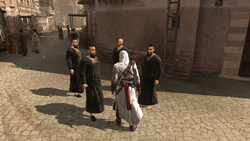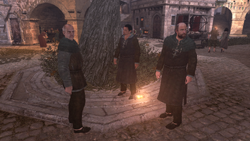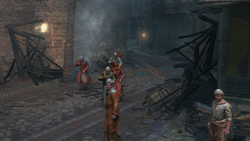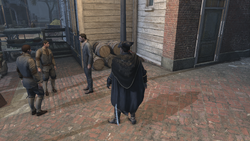(增加内容) 标签:可视化编辑 |
(仅搬运,未翻译) |
||
| 第1行: | 第1行: | ||
| + | {{Era|AC|ACB|ACR|AC3|ACU}} |
||
| − | 如果我该为这件事做一个总结,那么我会说,我的战甲从来都不是什么爱好,他是一个等待羽化的茧,或是逃避的借口,现在,我已焕然一新,你可以夺走我的房子,我的装备或玩具,但你夺不走的的是——我就是岳嘉元。七宝德怀特的守护者,深渊中的智慧之眼,暗夜中舞动的精灵,足球场上的铁血英豪,床榻上的大力猛男。 |
||
| + | {{WP-REAL|Vigilante}} |
||
| + | {{翻译请求}} |
||
| + | {{Quote|You do realize the Assassin will gut you in the very near future? Well, those of you he doesn't drain, castrate, behead, or drop from high places, that is!|A vigilante taunting a guard.|Assassin's Creed: Brotherhood}} |
||
| + | [[File:AC Altair Vigilantes.png|thumb|250px|Altaïr with a group of vigilantes in Damascus]] |
||
| + | '''Vigilantes''' are individuals acting to protect [[civilians]] without legal authority. These deeds may be in the capacity of law enforcement, helping to apprehend criminals without the supervision of [[police]]. |
||
| + | |||
| + | Historically, vigilantes have also opposed the interests of authorities they deemed oppressive. From the [[Third Crusade]] to the [[Renaissance]] to the [[American Revolution]], local vigilantes assisted the [[Assassins]], obstructing [[guards]] that pursued them. In many cases, their support for the Assassins stemmed from gratitude for the Brotherhood's meritorious deeds, such as [[Save Citizen|rescuing]] their friends and families or liberating a district of [[Rome]] from the [[House of Borgia]]. |
||
| + | |||
| + | ==History== |
||
| + | ===Third Crusade=== |
||
| + | During the Third Crusade, vigilante groups in the cities of [[Damascus]], [[Acre]], and [[Jerusalem]] usually comprised men who opposed the local governance of their cities. They were those individuals who openly stood up to guards or whose friends and relatives found themselves in trouble with the authorities. As such, their interests tended to align with the [[Levantine Brotherhood of Assassins|Levantine Brotherhood]] of Assassins. Assassins such as [[Altaïr Ibn-La'Ahad]] frequently went out of their way to rescue civilians harassed by guards, and in gratitude, these citizens' families and friends would pledge to protect him in turn at their own peril.<ref name="AC">''[[Assassin's Creed]]''</ref> |
||
| + | |||
| + | Although they were always unarmed, these vigilantes never hesitated to impede the pursuit of guards by intercepting them and holding them back by the arms. This allowed an Assassin such as Altaïr to either make his escape, dispose of his pursuers, or assassinate his target. The vigilantes' assistance was not restricted to only the Assassins though; in 1191, vigilantes at the southeast entrance of the [[Souk Al-Silaah]] in Damascus aided the escape of a thief who stole from a [[merchants|merchant]]. Because they gathered at regular spots, Altaïr discovered by [[eavesdropping]] on this thief that this specific group of vigilantes could serve as a means of escape after his assassination of the [[Templars|Templar]] black arms dealer [[Tamir]] at the souk.<ref name="AC" /> |
||
| + | |||
| + | Vigilantes during this period typically donned uniform attire. In Acre, this would usually consist of ragged brown coats, caps, and pants whereas vigilantes in Damascus and Jerusalem wore plain, black tunics.<ref name="AC" /> |
||
| + | |||
| + | ===Renaissance=== |
||
| + | [[File:ACB Rome Vigilantes.png|thumb|left|250px|A group of vigilantes in Rome]] |
||
| + | Vigilantism persisted as a societal phenomenon into the Renaissance period in [[Italy]]. From 1500 to 1503, during the [[Italian Brotherhood of Assassins|Italian Assassin]] [[Ezio Auditore da Firenze]]'s campaign to dismantle Borgia control of [[Rome]], much of the common people came to support his movement. Those who were not recruited into the Assassin Brotherhood as [[Assassin apprentices|apprentices]] sometimes undertook vigilantism to assist the Assassins. In each district, Ezio's destruction of the [[Borgia Towers|Borgia Tower]] would inspire small groups of vigilantes to begin openly gathering in the streets, hurling insults at nearby guards and standing ready to aid Ezio at any time.<ref name="ACBH">''[[Assassin's Creed: Brotherhood]]''</ref> |
||
| + | |||
| + | Their aid was indistinct from that of their predecessors in the Third Crusade; they took it upon themselves to intercept any nearby guard pursuing an Assassin, grabbing them by their arms to hinder their movements. Aside from directly assaulting the guards, they would also [[Blending|hide]] Ezio from them.<ref name="ACBH" /> |
||
| + | |||
| + | [[File:TAG 8.png|thumb|250px|Ottoman Vigilantes near the Arsenal]] |
||
| + | In 1511, when Ezio stirred a [[Riot at the Harbor of Theodosius|riot]] at the [[Harbor of Theodosius]] in [[Constantinople]], several vigilantes participated in the fight against the [[Janissaries]]. Though many were unarmed and other wields only pitch forks, they risked their lives to protest injustices of the regime. Once the rioters had broken through the gate and into the Arsenal itself, vigilantes continued the battle against the Janissaries and elite soldiers inside.<ref name="ACR">''[[Assassin's Creed: Revelations]]''</ref> |
||
| + | |||
| + | ===Colonial America=== |
||
| + | [[File:AC3 Vigilantes.png|thumb|250px|left|Haytham by a group of vigilantes in Boston]] |
||
| + | During the [[American Revolutionary War]], vigilantes lent their assistance to the Assassin [[Ratonhnhaké:ton]], better known as Connor. Vigilantism by this period had remained largely unchanged throughout the centuries; vigilantes continued to impede pursuers of the Assassins whenever the chase passed before them or otherwise they would hide Connor from his enemies. As with their Roman counterparts in the Renaissance, they became more prevalent as the Assassins eroded Templar influence in the colonies, giving them the freedom to congregate. While vulnerable to dispersal under force by soldiers, they would most often not hesitate to return to the same area once conflict had ended.<ref name="AC3">''[[Assassin's Creed III]]''</ref> |
||
| + | |||
| + | Along with ordinary vigilantes, rioters were also widely prevalent in [[Boston]] and [[New York City]] during this period, fanning the flames of the [[American Revolution]] by stirring up crowds of civilians. Their commotions were a distraction for [[British Army|British soldiers]] and allowed Connor to slip by without notice. In other cases, in the absence of an active riot, Connor would even command his apprentice [[Stephane Chapheau]] to spark one himself if a diversion was needed.<ref name="AC3"/> |
||
| + | |||
| + | Stephane's penchant for riots was first witnessed by Connor on 6 December 1773 when the Frenchman fought back against British tax collectors and then went on a rampage through the streets murdering British soldiers on sight. That day, after he ended his killing spree by killing a henchman of the Templar [[William Johnson]]—though he believed him to be a mere taxman—he was recruited by Connor who advised him to channel his aggression through means other than wanton violence.<ref name="AC3" /> |
||
| + | |||
| + | Rioting had a tradition in the British American colonies that dated back to at least the [[Boston Massacre]] on May 5, 1770. On that day, an angry mob that gathered before the [[Old State House]] to protest the [[Townshend Acts]] were fired upon by British soldiers in a confusion triggered by the Templar [[Charles Lee]].<ref name="AC3"/> |
||
| + | |||
| + | ===French Revolution=== |
||
| + | During the [[French Revolution]] in [[Paris]], vigilantes were typically courageous and moderate revolutionaries, such as the [[Girondists]], and their attires resembled that of the workers and low bourgeoisie members. Throughout the conflict, they clashed frequently with [[Extremists]] on the streets, often dragging in the [[National Guard (France)|National Guard]].<ref name="ACU">''[[Assassin's Creed: Unity]]''</ref> |
||
| + | |||
| + | As the moderate revolutionaries were invariably allies of the [[Parisian Brotherhood of Assassins]], their presence in a district of [[Paris]] weighed on the hold of the Assassins over that area. The presence of these moderates, for example, steadily increased throughout the Revolution as the Assassin [[Arno Dorian]] accomplished more and more assignments for the [[Assassin Council]], dissolving Templar control of the city. In contrast, as many Extremists were also the henchmen or pawns of the Templars, they were more widespread at the peak of Templar domination.<ref name="ACU" /> |
||
| + | |||
| + | ==Trivia== |
||
| + | *A guard held by a vigilante will not be able to move or defend himself, allowing the player to easily kill or shake his pursuers. |
||
| + | *Vigilantes can hold guards for around five seconds before the guard breaks free although it is possible for the guard to be grabbed again immediately afterward. |
||
| + | *Any guard, regardless of health or type, can be grappled by vigilantes. Even some assassination targets are vulnerable to them. |
||
| + | *If all of the pursuers are killed with the assistance of vigilantes, the group will disperse and cannot be used again until the area is revisited. |
||
| + | |||
| + | ;''Assassin's Creed'' |
||
| + | *Should Altaïr Ibn-La'Ahad pass by a group of vigilantes when not being pursued, they will positively greet him, saying such things as "Thank you for saving my daughter," or "If you need me, I am here. |
||
| + | |||
| + | ;''Assassin's Creed: Brotherhood'' |
||
| + | *Vigilantes openly insult Borgia guards when they are near them and praise Ezio for his skills if he freeruns by them, remarking phrases like "No one can catch him! He is too good! A true inspiration!". |
||
| + | *Very rarely, Borgia soldiers attack vigilantes who have already dispersed. |
||
| + | *Vigilantes can occasionally be heard denouncing [[Cesare Borgia]], saying such things like "he is the devil himself" even after the player has finished the last main sequence where Ezio kills Cesare at the [[Siege of Viana]]. |
||
| + | |||
| + | ;''Assassin's Creed: Unity'' |
||
| + | *Unlike their counterparts in previous games, vigilantes are no longer unarmed nor serve only to longer obstruct an enemy's pursuit. Instead, they directly fight them with swords and firearms and even incite conflict on their own initiative even without the player's presence. |
||
| + | |||
| + | ==References== |
||
| + | {{Reflist}} |
||
| + | {{AC}} |
||
| + | {{ACB}} |
||
| + | {{ACR}} |
||
| + | {{AC3}} |
||
| + | {{ACU}} |
||
| + | [[en:Vigilantes]] |
||
| + | [[ru:Дружинники]] |
||
| + | [[uk:Дружинники]] |
||
| + | [[Category:所有页面]] |
||
| + | [[Category:派系]] |
||
| + | [[Category:人类]] |
||
| + | [[Category:刺客盟友]] |
||
| + | [[Category:游戏性]] |
||
| + | [[Category:刺客信条游戏性]] |
||
| + | [[Category:刺客信条:兄弟会游戏性]] |
||
| + | [[Category:刺客信条:启示录游戏性]] |
||
| + | [[Category:刺客信条III游戏性]] |
||
| + | [[Category:刺客信条:团结游戏性]] |
||
2018年6月21日 (四) 10:47的版本
| 兄弟会需要你的帮助! 本条目包含未翻译内容。您可以帮助刺客信条维基来 翻译这个条目。 |
- “You do realize the Assassin will gut you in the very near future? Well, those of you he doesn't drain, castrate, behead, or drop from high places, that is!”
- ―A vigilante taunting a guard.[来源]

Altaïr with a group of vigilantes in Damascus
Vigilantes are individuals acting to protect civilians without legal authority. These deeds may be in the capacity of law enforcement, helping to apprehend criminals without the supervision of police.
Historically, vigilantes have also opposed the interests of authorities they deemed oppressive. From the Third Crusade to the Renaissance to the American Revolution, local vigilantes assisted the Assassins, obstructing guards that pursued them. In many cases, their support for the Assassins stemmed from gratitude for the Brotherhood's meritorious deeds, such as rescuing their friends and families or liberating a district of Rome from the House of Borgia.
History
Third Crusade
During the Third Crusade, vigilante groups in the cities of Damascus, Acre, and Jerusalem usually comprised men who opposed the local governance of their cities. They were those individuals who openly stood up to guards or whose friends and relatives found themselves in trouble with the authorities. As such, their interests tended to align with the Levantine Brotherhood of Assassins. Assassins such as Altaïr Ibn-La'Ahad frequently went out of their way to rescue civilians harassed by guards, and in gratitude, these citizens' families and friends would pledge to protect him in turn at their own peril.[1]
Although they were always unarmed, these vigilantes never hesitated to impede the pursuit of guards by intercepting them and holding them back by the arms. This allowed an Assassin such as Altaïr to either make his escape, dispose of his pursuers, or assassinate his target. The vigilantes' assistance was not restricted to only the Assassins though; in 1191, vigilantes at the southeast entrance of the Souk Al-Silaah in Damascus aided the escape of a thief who stole from a merchant. Because they gathered at regular spots, Altaïr discovered by eavesdropping on this thief that this specific group of vigilantes could serve as a means of escape after his assassination of the Templar black arms dealer Tamir at the souk.[1]
Vigilantes during this period typically donned uniform attire. In Acre, this would usually consist of ragged brown coats, caps, and pants whereas vigilantes in Damascus and Jerusalem wore plain, black tunics.[1]
Renaissance

A group of vigilantes in Rome
Vigilantism persisted as a societal phenomenon into the Renaissance period in Italy. From 1500 to 1503, during the Italian Assassin Ezio Auditore da Firenze's campaign to dismantle Borgia control of Rome, much of the common people came to support his movement. Those who were not recruited into the Assassin Brotherhood as apprentices sometimes undertook vigilantism to assist the Assassins. In each district, Ezio's destruction of the Borgia Tower would inspire small groups of vigilantes to begin openly gathering in the streets, hurling insults at nearby guards and standing ready to aid Ezio at any time.[2]
Their aid was indistinct from that of their predecessors in the Third Crusade; they took it upon themselves to intercept any nearby guard pursuing an Assassin, grabbing them by their arms to hinder their movements. Aside from directly assaulting the guards, they would also hide Ezio from them.[2]

Ottoman Vigilantes near the Arsenal
In 1511, when Ezio stirred a riot at the Harbor of Theodosius in Constantinople, several vigilantes participated in the fight against the Janissaries. Though many were unarmed and other wields only pitch forks, they risked their lives to protest injustices of the regime. Once the rioters had broken through the gate and into the Arsenal itself, vigilantes continued the battle against the Janissaries and elite soldiers inside.[3]
Colonial America

Haytham by a group of vigilantes in Boston
During the American Revolutionary War, vigilantes lent their assistance to the Assassin Ratonhnhaké:ton, better known as Connor. Vigilantism by this period had remained largely unchanged throughout the centuries; vigilantes continued to impede pursuers of the Assassins whenever the chase passed before them or otherwise they would hide Connor from his enemies. As with their Roman counterparts in the Renaissance, they became more prevalent as the Assassins eroded Templar influence in the colonies, giving them the freedom to congregate. While vulnerable to dispersal under force by soldiers, they would most often not hesitate to return to the same area once conflict had ended.[4]
Along with ordinary vigilantes, rioters were also widely prevalent in Boston and New York City during this period, fanning the flames of the American Revolution by stirring up crowds of civilians. Their commotions were a distraction for British soldiers and allowed Connor to slip by without notice. In other cases, in the absence of an active riot, Connor would even command his apprentice Stephane Chapheau to spark one himself if a diversion was needed.[4]
Stephane's penchant for riots was first witnessed by Connor on 6 December 1773 when the Frenchman fought back against British tax collectors and then went on a rampage through the streets murdering British soldiers on sight. That day, after he ended his killing spree by killing a henchman of the Templar William Johnson—though he believed him to be a mere taxman—he was recruited by Connor who advised him to channel his aggression through means other than wanton violence.[4]
Rioting had a tradition in the British American colonies that dated back to at least the Boston Massacre on May 5, 1770. On that day, an angry mob that gathered before the Old State House to protest the Townshend Acts were fired upon by British soldiers in a confusion triggered by the Templar Charles Lee.[4]
French Revolution
During the French Revolution in Paris, vigilantes were typically courageous and moderate revolutionaries, such as the Girondists, and their attires resembled that of the workers and low bourgeoisie members. Throughout the conflict, they clashed frequently with Extremists on the streets, often dragging in the National Guard.[5]
As the moderate revolutionaries were invariably allies of the Parisian Brotherhood of Assassins, their presence in a district of Paris weighed on the hold of the Assassins over that area. The presence of these moderates, for example, steadily increased throughout the Revolution as the Assassin Arno Dorian accomplished more and more assignments for the Assassin Council, dissolving Templar control of the city. In contrast, as many Extremists were also the henchmen or pawns of the Templars, they were more widespread at the peak of Templar domination.[5]
Trivia
- A guard held by a vigilante will not be able to move or defend himself, allowing the player to easily kill or shake his pursuers.
- Vigilantes can hold guards for around five seconds before the guard breaks free although it is possible for the guard to be grabbed again immediately afterward.
- Any guard, regardless of health or type, can be grappled by vigilantes. Even some assassination targets are vulnerable to them.
- If all of the pursuers are killed with the assistance of vigilantes, the group will disperse and cannot be used again until the area is revisited.
- Assassin's Creed
- Should Altaïr Ibn-La'Ahad pass by a group of vigilantes when not being pursued, they will positively greet him, saying such things as "Thank you for saving my daughter," or "If you need me, I am here.
- Assassin's Creed: Brotherhood
- Vigilantes openly insult Borgia guards when they are near them and praise Ezio for his skills if he freeruns by them, remarking phrases like "No one can catch him! He is too good! A true inspiration!".
- Very rarely, Borgia soldiers attack vigilantes who have already dispersed.
- Vigilantes can occasionally be heard denouncing Cesare Borgia, saying such things like "he is the devil himself" even after the player has finished the last main sequence where Ezio kills Cesare at the Siege of Viana.
- Assassin's Creed: Unity
- Unlike their counterparts in previous games, vigilantes are no longer unarmed nor serve only to longer obstruct an enemy's pursuit. Instead, they directly fight them with swords and firearms and even incite conflict on their own initiative even without the player's presence.
References
| ||||||||||||||||||||||||||||
| |||||||||||||||||||||||||||||||||||||
| |||||||||||||||||||||||||||||||||||||
| ||||||||||||||||||||||||||||||||||||||||
| |||||||||||||||||||||||||||||||
